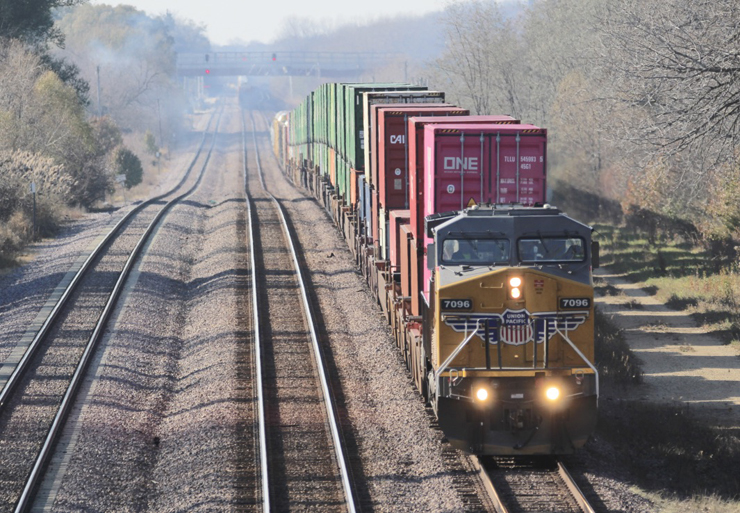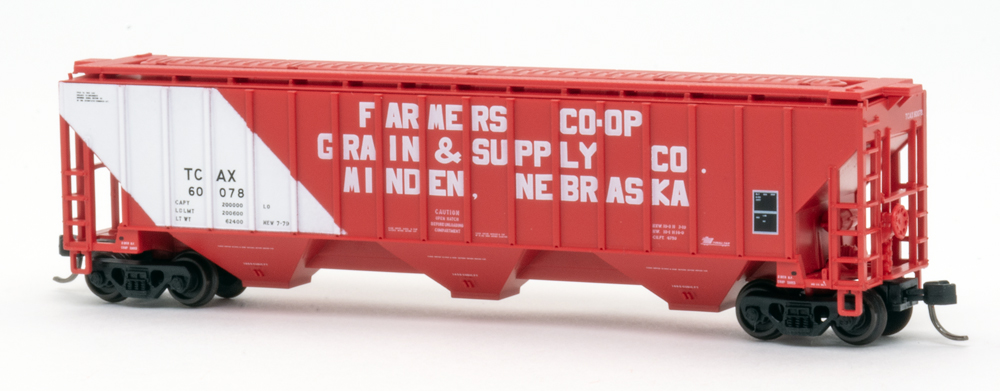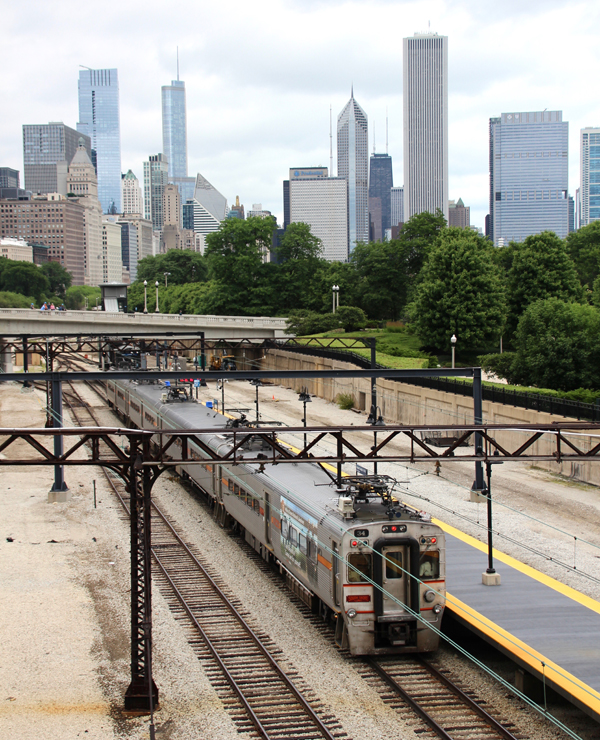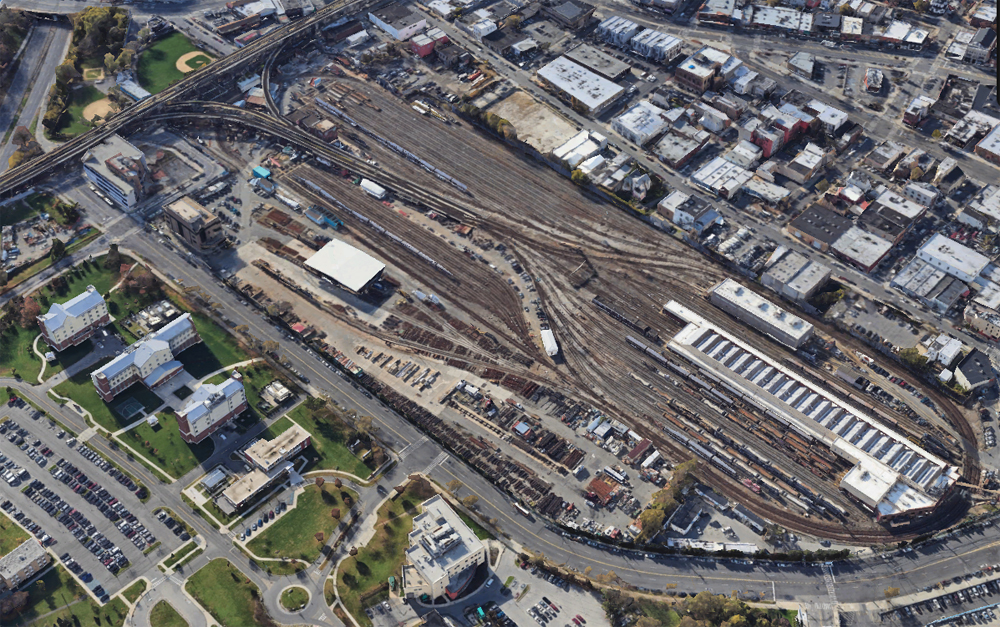
WASHINGTON — The Surface Transportation Board, making clear its unhappiness with service recovery plans filed by the four largest U.S. Class I railroads, will require those railroads to correct deficiencies in service recovery plans submitted to the board, and to provide additional information on how they plan to improve service and communication with customers.
At least two of the railroads face the prospect of financial penalties if they do not provide sufficiently improved plans. The new plans are due June 23.
The plans submitted by BNSF Railway, CSX Transportation, Norfolk Southern, and Union Pacific “were perfunctory and lacked the level of detail that was mandated by the Board’s order,” the board said in a Monday release announcing its new order. Those plans were in response to an order issued by the board in May [see “Federal regulators order railroads to provide more service data …,” Trains News Wire, May 6, 2022], with initial six-month plans filed later that month [see “Railroads outline six-month service recovery plans …,” News Wire, May 23, 2022].
In Monday’s release, STB Chairman Martin Oberman said the railroads’ plans “are woefully deficient and do not comport with the spirit or the letter of the Board’s order. The plans simply failed to instill confidence that the carriers have a serious approach to fixing a problem caused by their own lack of preparedness to respond to external shocks and fluctuations in demand, including especially short-sighted management of labor forces and other resources. While the railroads must always comply with Board orders, it is particularly disturbing that the railroads failed to comply with the order requiring them to file adequate service recovery plans. … I had expected a better response from the carriers to the Board’s previous order, and now with more explicit instructions, which should not have been needed, there will be no excuse for continued lack of compliance.”
The board’s 19-page decision also notes two railroads were almost a week late in filing April 2022 employment data, and that “even with the additional time, one carrier’s filings had deficiencies so serieous that that the data was rendered functionally useless. … The carriers must treat the data reporting requirement with the seriousness and diligence called for by the prevailing challenges in the freight network.
The decision calls for railroads to outline specific actions to improve service, particularly calling for details on how they will “remedy their current labor shortage and avoid future labor shortages” (emphasis in the original). It calls for target numbers for workers on the job in six months and one year, detailed by type of worker: train and engine; maintenance of way and structures; maintenance of equipment and stores; customer service employees; and all other personnel.
They must also provide details of incentives to attract and keep employees, and on numbers regarding employee training; provide details on velocity restrictions and power usage; and to “explain, with precision” how their actions will improve the metrics they use to evaluate performance.
Also, the 36 months of data that was required in filings earlier this month must now be broken down to a weekly level to “give the Board and the public a clearer sense as to the Carriers’ pre-pandemic performance and week-to-week variability. This in turn will allow the Board and other to better evaluate the adequancy of the Carriers’ ongoing recovery.”
Monday’s decision also assesses the original service recovery plans for each of the four railroads, saying BNSF “provided the most comprehensive” plan while Union Pacific’s “was by far the worst of all Carriers and reflected an attitude of indifference” to both its service issues and the STB’s oversight.
“Although there is already adequate justification for the Board to impose monetary penalties on UP for its continued violations of the May 6 order [requiring the service recovery plans] … the Board will defer any decision concerning the imposition of penalties until UP has had an opportunity to correct its filing and comply with the initial order,” the decision states. Norfolk Southern could also face penalties, the board said, if it fails to provide “clear six-month targets” for improvement in its performance metrics.














All will be well. The railroads have been scolded.
The big mergers in the 1980’s started the bad time management of railroad freight. It seemed management was more concerned at eliminating what they called excessive mileage and duplication resulting from mergers. And they became more focused on installing “”their style of operating” rather than accepting things that worked. The UP-SP problems being the prime example but, there were many others. Most worrisome was managements bowing to Wall St. and executive bonus tricks. Remember the bonus UP officers got if the company made a 5% return on investment and how that tied up the railroad ? It is apparent that executive income is the ill affecting railroads ability to move freight rather than providing reliable service. They are fast to stop labors cash outflow (layoffs) more than protecting the ability to provide reliable service. And, that has to change. Government oversight and management of railroads has a history poor reputation but, maybe threats of government control will shake management up. Something needs to.
Got a great solution to a couple of the problems the railroads are having:
(1) Get rid of the bean counters in charge. They focus on one thing, the bottom line. This has lead them to this disaster. This is like a fighter pilot who concentrates only on the target to shoot him down. He/She forgets everything else around them and ends up flying into the ground.
When the bean counters got control of GM in the late 1970’s they focused so much on the bottom line they forgot to give their customers what they wanted, (safe, reliable, well built cars that got decent millage and had some style). GM got greedy, making the unions wanting more; but causing dissatisfied customers to look elsewhere for what they want/need, eventually leading GM to file bankruptcy 30 years later. Kinda looks like the trend the RR’s are following now.
(2) Part 2 of solution is have STB mandate that if the employment policy requires someone to be at work 28 or 29 days out of every 30, that should include “ALL” management. If the lowest of the employment ladder can’t have a life, the top rung shouldn’t have one either.
(3) STB needs to put foot down. Legally they probably can’t control of a company, but they can fine the company and it’s managers personally. Dollars talk.
Tell each company they have a time limit (say 90 or 180 days) to get their house in order. If not substantially done, fines all around, especially a progressive fine. Start with a penny the first day and double it every day till goal is met. This way after 24 days the fines are in the $100’s of thousands, 27 days in the millions, 30 days in the $10’s of millions and so on. When the fines get so high that the price of stock goes through the floor the Wall Street managers won’t be so greedy.
1. I’m not suggesting that the class 1s are blameless but is there any reason to believe lifetime bureaucrats such as Oberman know how to run RRs (eg, throttle settings, appropriate # of locomotives, anticipating and immediately responding to all the things that impact RR ops that are out of the RRs’ control (eg, bad weather, grade crossing incidents, Amtrak’s poor performance, etc)). Does Oberman believe RRs are wrong to be motivated to minimize their carbon-based fuel consumption as oil prices and the greens’ agenda surge?
2. Re: operating personnel staffing, will Oberman (as a proxy for labor supporting Congress people) be happy with RR’s going to one man crews in PTC operating areas as a means of spreading what personnel they manage to hire across operations?
3. STB micromanagement may backfire eg, mandating RRs run trains at “track speed” may result in more miles of track with reduced maximum authorized speed.
4. Do RRs as publicly traded companies have a basis for suing the activist STB to stay its extensive operational directives given their potential impact in RRs’ ability to finance their operations/capital investments in a competitive equities market?
As to your point #1 the bureaucrats might look out for the good of the country; something the current management is not doing.
I have the perfect plan for making the railroads shape up:
Threaten them with nationalization.
That’s what Matt Rose said would happen. He is starting to look right. And a recession is on its way.
I don’t think the shareholders are getting their monies worth for the amount of money the big 4 are paying their execs. Also if PRS is so great then how come they can’t schedule regular work hours for engine crews. I am not impressed with the management for these companies.
Present day conundrum in RR operations. Run the RR and please both the investor AND do “due diligance” to expenditures for best operating practices. It seems either/or and the part that gets left out is what the STB wants to see. But the RR would rather not share that information. It remains to be seen how strong the STB will be.
I love railroad executives so much that perhaps a million dollars a day fine until they submit what’s been requested would relieve their apathy.
Not sure exactly what Oberman expects the RR’s to do about people that just don’t want to work…and don’t believe those same people that are saying it’s not that we don’t want to work, we just want to work for a living wage. Well, the RR’s pay above a living wage and they still can’t hire people…so make up your minds gen Z, either you want to work or you don’t?
You can blame Gen Z or the workforce or society or people or whoever else you want to blame for the railroads staffing problems but ultimately the bottom line is, the employer has work to be done and must do what it can to get the people to do it.
I can bemoan how I cannot find anyone to mow my grass for 25 bucks which is what it used to cost because now they all want 35 bucks. The grass keeps growing. Suck it up and pay the man.
Mr. McFarlane Gen Z may be smarter than you think they are. Maybe they are not interested in a job whose work hours are almost totally unpredictable. And maybe they want longer-term employment security not a job with a stupid railroad that stands a good chance of laying them off within 3-6 years. The history of railroad employment levels suggests that only an idiot would be wiling subsect themselves to a job with litter or no job security.
The current unemployment figures of 3.5% fly in the face of the widespread notion that people don’t want to work. This is about as close to full employment as we’re likely to see, and the increased wages we are seeing are reflecting this shortage. But go ahead and assume all these problems are because people are lazy…….
Gerald it isn’t Gen Z with 10 to 20 years service that are leaving. Word on the rails is don’t come to work here. I, myself, have 26+ years of service and have had enough and taking early retirement. My new employment has good benefits at 50% of the pay. BUT. They pay monthly bonuses based on productivity and quarterly safety bonuses. That has the potential to close the pay gap quite a bit. They don’t lay anyone off when business is down. I’m home everyday. Managers aren’t hiding in the weeds or randomly downloading looking for petty things to haul me into an investigation. Safety is first. There philosophy is we pay you by the hour so there is absolutely no reason to hurry or cut corners. And the rules aren’t a revolving door of changes that are at times difficult to keep up with. The veterans of the railroad are telling Gen Z it ain’t worth it.
Why do you seem to always be so out of touch with things?
All of this wreckage was created by one man, EHH. The aftermath of it was to inspire unbounded greed on the part of Wall Street, the major (institutional) shareholders, and the top level management teams. I hope the STB sticks it to them big time for what they’ve done to a once thriving transportation system.
@Al Dicenso: With all due respect, sir, “EHH” is Edward H. Harriman. Hunter Harrison would not make a pimple on EHH’s posterior.